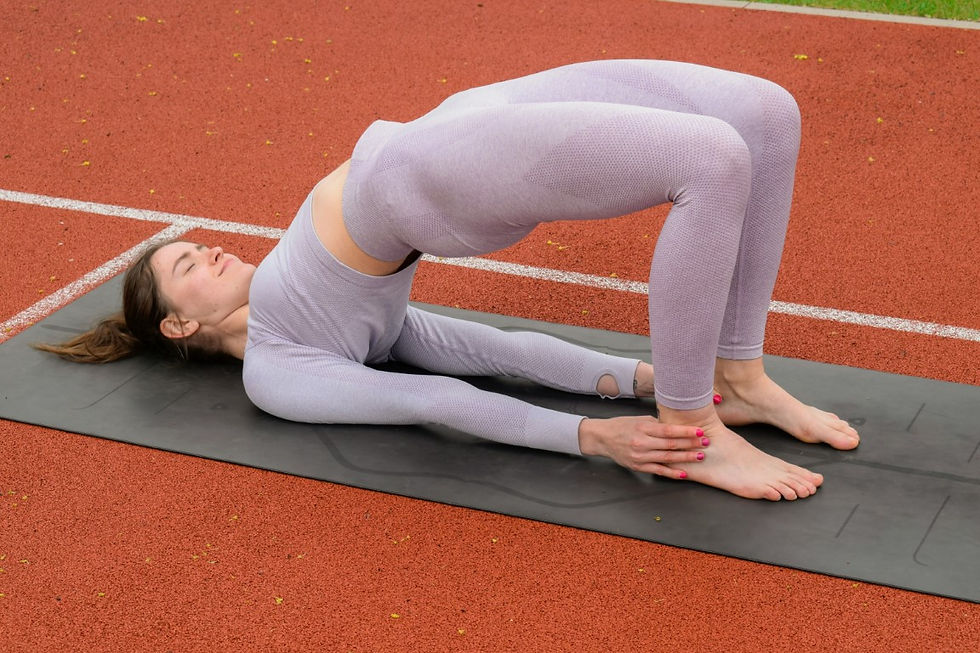Mindful Movement: A Practical Guide to Yoga for Sports Injury Prevention
- Paul McAvoy

- Mar 29, 2024
- 4 min read
This week we thought we'd have a look at the benefits of yoga for injury prevention among athletes. The benefits of yoga are widely known, from increasing flexibility and mobility to providing head space to get away from the stresses of the day to day. But for athletes and individuals wanting to get the most from yoga without a full time investment in the practise, we wondered which 5 yoga poses would be of most value? After a brief consult with Matt Mahon, our resident yogi in chief and instructor at our Thursday evening yoga class, we distilled them down to the following five.

Today's blog is a short dive into the world of mindful movement. We will explore how some simple yoga poses could be your secret weapon against sports injuries. No fluff, just practical advice that could very well stave off your next injury.
Why Yoga?
Yoga isn't just for meditation junkies; it's a powerhouse for injury prevention in sports. Here's the low-down on how it works:
Strengthens Muscles: Active yoga poses engage various muscle groups, helping you build strength evenly usually through isometric holds in a static position (in other words it develops stability). This means fewer weak links in your athletic chain, reducing the risk of injuries caused by muscle imbalances.
Improves Flexibility: Tight muscles are like ticking time bombs. Yoga stretches them out, making you more flexible and less prone to strains and pulls during sports activities. The longer and more pliable your muscles the less chance of an unexpected pull when you are tired and perhaps moving with less accuracy than is good for you!
Enhances Balance: Ever stumbled during a crucial play? Yoga poses, especially those challenging your balance, sharpen your proprioception – the body's sense of where it is in space. Better balance equals fewer embarrassing falls.
Now, let's get down to business with our top five practical yoga poses and how to perform them:
1. Downward-Facing Dog (Adho Mukha Svanasana):

Why: Strengthens arms, shoulders, and legs; improves flexibility.
How:
Start on your hands and knees.
Lift your hips toward the ceiling, straightening your legs.
Keep your hands shoulder-width apart and feet hip-width apart.
Aim to create an inverted V shape with your body.
Hold for 30 seconds to 1 minute, breathing deeply.
2. Warrior II (Virabhadrasana II):

Why: Builds strength in the legs and opens hips; enhances balance.
How:
Begin in a standing position.
Step one foot back, keeping the front knee bent.
Extend your arms parallel to the floor, reaching in opposite directions.
Turn your head to face the front hand.
Hold for 30 seconds to 1 minute, then switch sides.
3. Tree Pose (Vrikshasana):

Why: Strengthens ankles and improves balance.
How:
Stand on one leg.
Place the sole of the other foot on the inner thigh or calf (avoid the knee).
Bring your hands together in front of your chest or extend them overhead.
Hold for 30 seconds to 1 minute, then switch sides.
4. Bridge Pose (Setu Bandhasana):

Why: Strengthens the core, glutes, and lower back; opens the chest.
How:
Lie on your back with knees bent and feet hip-width apart.
Press through your feet to lift your hips toward the ceiling.
Clasp your hands under your back and roll your shoulders underneath.
Hold for 30 seconds to 1 minute.
5. Child's Pose (Balasana):

Why: Restores and relaxes the body; stretches the back.
How:
Kneel on the mat with your big toes touching and knees apart.
Sit back on your heels and reach your arms forward.
Rest your forehead on the mat and relax for 1-2 minutes.
Remember if you want results, the key is consistency. Incorporate these poses into your routine a few times a week, and you'll be on your way to a stronger, more injury-resistant athletic self.
Look out for future posts from Matt himself which will delve into the effects of yoga on energy systems and mental well-being. If you want to get a head start with yoga, you can always pop along to our Thursday evening vinyasa class with Matt from 6-7pm. A challenging class for all abilities that will take you though all of the above and more. Class costs at time of writing £10pp.
Disclaimer please note well: The information provided on this health and well-being blog is intended for general informational purposes only and should not be considered as professional medical advice. The content is not intended to be a substitute for professional medical diagnosis, treatment, or guidance. Always seek the advice of your physician or other qualified health provider with any questions you may have regarding a medical condition.
Never disregard professional medical advice or delay seeking it because of something you have read on this blog. If you think you may have a medical emergency, call your doctor or the emergency services immediately.
The authors of this blog are not medical professionals, and the content provided here is based on personal experiences, research, and general knowledge. It is important to consult with a qualified healthcare professional for individual health concerns. The use of any information provided on this blog is solely at your own risk. The authors, contributors, and the website owner disclaim any responsibility for any adverse effects resulting directly or indirectly from the information provided.
By accessing and using this blog, you acknowledge and agree to these terms and conditions.







Comments